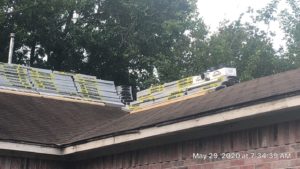 Occasionally, you might encounter one or two roof features that serve no function other than architectural interest. However, your fascia boards and soffits are not among them. They are essential parts of your roof structure that help keep water, rodents, and insects out of your attic space, but they also play a role in your home’s ventilation. There is no definite timetable for replacing a soffit or fascia, but there are some signs that roof repair contractors look for when evaluating your roof’s overall health.
Occasionally, you might encounter one or two roof features that serve no function other than architectural interest. However, your fascia boards and soffits are not among them. They are essential parts of your roof structure that help keep water, rodents, and insects out of your attic space, but they also play a role in your home’s ventilation. There is no definite timetable for replacing a soffit or fascia, but there are some signs that roof repair contractors look for when evaluating your roof’s overall health.
How Often Should I Replace My Roof’s Soffit and Fascia?
Are There Signs of Pests in the Attic or on the Soffits or Fascia Boards?
If you hear unexplained noises above your ceiling or find droppings or nests in your attic, you may have a problem with your fascia boards or soffits. Squirrels, birds, and a variety of other creatures may decide that your attic is an ideal environment to shelter from the weather, especially in the winter, or when it is time for them to find a haven to rear their young.
Are There Signs of Water Leaks Near the Edges of Your Attic?
If they are damaged or improperly attached, fascia boards and soffit can allow water to leak into your attic. Initially, the leak may only manifest near the entry point, and the only evidence may be damp spots or water stains on your attic insulation. Eventually, the leak can progress and reach the interior of your home. The moisture can also allow colonies of mildew or mold to grow without your notice.
Is the Paint on Your Fascia Boards or Soffits Cracked, Blistered, or Peeling?
The primary purpose of paint is to seal the wood against the elements. Damaged paint is often a sign that water has already penetrated the wood, and it may have progressed into your attic. Although it is possible to scrape and repaint fascia boards or soffits, the results may not be satisfactory. An ideal time to replace damaged fasciae and soffits is when you have a contractor install a new roof. If your roof replacement is an insurance restoration, ask your claims adjuster to include the replacement of any damaged fascia or soffit.
Are There Signs of Inadequate Ventilation?
Ventilation, especially in the attic, is an essential contributor to your home’s comfort and the size of your energy bills. Adequate ventilation helps control moisture, heat, and condensation that can increase your heating and cooling bills, cause wood to rot, or lead to mold or mildew. Inadequate ventilation may be the result of damaged or blocked fascia boards or soffits.
Are There Problems With the Gutters?
On most homes, gutter fasteners are attached to the fascia boards. A damaged fascia can allow your gutter to sag or leak. When gutters cannot do their job, water can leak into wall voids, accumulate near your foundation, back up under the edge of your roof, or damage your siding.
Is Asbestos Present?
Asbestos is a dangerous mineral that becomes even more hazardous as it deteriorates. Older homes, in particular, may have fascia boards or soffits that contain asbestos. Asbestos removal requires special training and equipment, so you should contact an experienced Austin roofer to work with you to create a plan to remove it safely.
Can Alpha Assist Me?
Alpha Roofing Industries, a leading Texas roofing company, is ready to help. We offer an extensive list of roofing services, including roof repairs, asphalt shingle installation, chimney repair, skylight installation, debris and moss removal, roof inspections, metal roof installation, flashing repairs, and flat roof installations. We also provide commercial roofing services. We have an unrivaled reputation for delivering work of the highest quality and unparalleled customer service at affordable prices. We offer free job quotes and roof inspections, so call our Round Rock office at 512-777-1086 or fill out our form online to request yours today.
